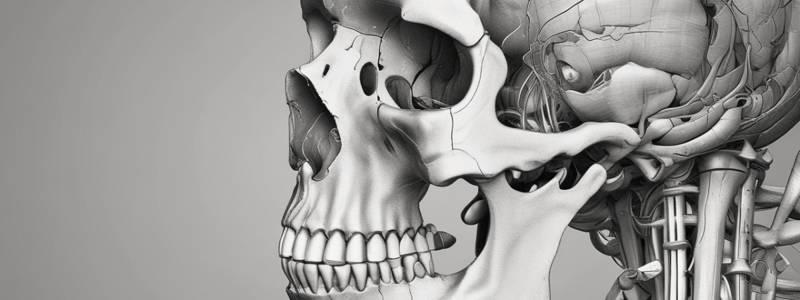Podcast
Questions and Answers
What type of fracture occurs when a bone is weakened by a medical condition?
What type of fracture occurs when a bone is weakened by a medical condition?
- Avulsion fracture
- Comminuted fracture
- Closed fracture
- Pathological fracture (correct)
What is the main difference between a closed fracture and a compound fracture?
What is the main difference between a closed fracture and a compound fracture?
- The location of the fracture
- The damage to surrounding tissue (correct)
- The severity of the impact
- The age of the person
What is the result of a muscle or ligament pulling on a bone?
What is the result of a muscle or ligament pulling on a bone?
- A comminuted fracture
- A pathological fracture
- A closed fracture
- An avulsion fracture (correct)
What is a characteristic of a comminuted fracture?
What is a characteristic of a comminuted fracture?
What determines the symptoms of a fracture?
What determines the symptoms of a fracture?
What is a common symptom of a fracture?
What is a common symptom of a fracture?
What is used to fully assess the fracture in some cases?
What is used to fully assess the fracture in some cases?
What is the primary focus of treatment for a fracture?
What is the primary focus of treatment for a fracture?
What can affect the healing time of a fracture?
What can affect the healing time of a fracture?
What may be used to fixate the bone in place?
What may be used to fixate the bone in place?
What is a modifiable risk factor for bone fractures?
What is a modifiable risk factor for bone fractures?
What is essential for the body to absorb calcium?
What is essential for the body to absorb calcium?
What type of exercise can help improve bone density?
What type of exercise can help improve bone density?
What is a good source of calcium?
What is a good source of calcium?
What is a risk factor for bone fractures that can be reduced through lifestyle changes?
What is a risk factor for bone fractures that can be reduced through lifestyle changes?
Flashcards are hidden until you start studying
Study Notes
What is a Bone Fracture?
- A bone fracture is a crack or break in a bone.
- It can occur in any bone in the body.
- There are several ways a bone can fracture.
Types of Fractures
- Closed fracture: a break in the bone that does not damage surrounding tissue or tear through the skin.
- Compound fracture: a break in the bone that damages surrounding tissue and penetrates the skin.
- Avulsion fracture: a muscle or ligament pulls on the bone, fracturing it.
- Comminuted fracture: an impact shatters the bone into many pieces.
Symptoms of Fractures
- Pain
- Swelling
- Bruising
- Discolored skin around the affected area
- Protrusion of the affected area at an unusual angle
- Inability to put weight on the injured area
- Inability to move the affected area
- Grating sensation in the affected bone or joint
- Bleeding if it is an open fracture
Diagnosis
- History of trauma
- Physical examination
- X-ray
- In some cases, an MRI or CT scan may be used to fully assess the fracture.
Treatment
- Bone healing typically occurs naturally.
- Treatment focuses on providing the injured bone with the best circumstances for healing and ensuring optimal future function.
- Methods of fixation include:
- Casts or braces
- Metal plates and screws
- Intramedullary nails or rods
- External fixings
Healing and Complications
- Fractures can take several weeks to several months to heal.
- Healing time depends on:
- Severity of the fracture
- Bone affected
- Complications such as infection or blood supply problems
- Smoking, excessive alcohol consumption, high body mass index, and NSAID use
- Age
Prevention
- A person's diet can affect their risk of fractures.
- Adequate supplies of calcium and vitamin D are necessary for healthy bones.
- Good sources of calcium include:
- Milk
- Cheese
- Yogurt
- Dark green leafy vegetables
- Good sources of vitamin D include:
- Sunlight
- Eggs
- Oily fish
- Engaging in weight-bearing exercise can help improve muscle mass and bone density, reducing the risk of bone fractures.
Studying That Suits You
Use AI to generate personalized quizzes and flashcards to suit your learning preferences.



